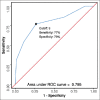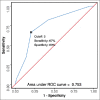Utility of the RIPS Scale and 2CAN Score for In-Hospital Stroke Prediction
- PMID: 37179682
- PMCID: PMC10170998
- DOI: 10.4103/aian.aian_879_22
Utility of the RIPS Scale and 2CAN Score for In-Hospital Stroke Prediction
Abstract
Background: In-hospital strokes are a small but sizeable proportion of all strokes. Identification of in-hospital strokes is confounded by stroke mimics in as many as half of in-patient stroke codes. A quick scoring system based on risk factors and clinical signs during the initial evaluation of a suspected stroke might be helpful to distinguish true strokes from mimics. Two such scoring systems based on ischemic and hemorrhagic risk factors are the risk for in-patient stroke (RIPS) and the 2CAN score.
Materials and methods: This prospective clinical study was conducted at a quaternary care hospital in Bengaluru, India. All hospitalized patients aged 18 years and above for whom a "stroke code" alert was recorded during the study period of January 2019 to January 2020 were included in the study.
Results: A total of 121 in-patient "stroke codes" were documented during the study. Ischemic stroke was the most common etiological diagnosis. A total of 53 patients were diagnosed to have ischemic stroke, 4 had intracerebral hemorrhage, and the rest were mimics. Receiver operative curve analysis was performed and at a cut-off of RIPS ≥3, it predicts stroke with a sensitivity of 77% and a specificity of 73%. At a cut-off of 2CAN ≥3, it predicts stroke with a sensitivity of 67% and a specificity of 80%. RIPS and 2CAN significantly predicted stroke.
Conclusions: There was no difference in the use of either RIPS or 2CAN for differentiating stroke from mimics, and hence they may be used interchangeably. They were statistically significant with good sensitivity and specificity, as a screening tool to determine in-patient stroke.
Keywords: 2CAN; RIPS; in-hospital stroke; stroke.
Copyright: © 2023 Annals of Indian Academy of Neurology.
Conflict of interest statement
There are no conflicts of interest.
Figures
References
-
- Park HJ, Cho HJ, Kim YD, Lee DW, Choi HY, Kim SM, et al. Comparison of the characteristics for in-hospital and out-of-hospital ischaemic strokes. Eur J Neurol. 2009;16:582–8. - PubMed
-
- Kassardjian CD, Willems JD, Skrabka K, Nisenbaum R, Barnaby J, Kostyrko P, et al. In-patient code stroke. Stroke. 2017;48:2176–83. - PubMed
-
- Cumbler E, Simpson J. Code stroke:Multicenter experience with in-hospital stroke alerts. J Hosp Med. 2015;10:179–83. - PubMed
-
- Chang P, Bergman D, Prabhakaran S. The risk for in-patient stroke (RIPS) scale:Development of a stroke recognition instrument (P6.027) Neurology. 2016;86(16 Suppl):P6.027.




